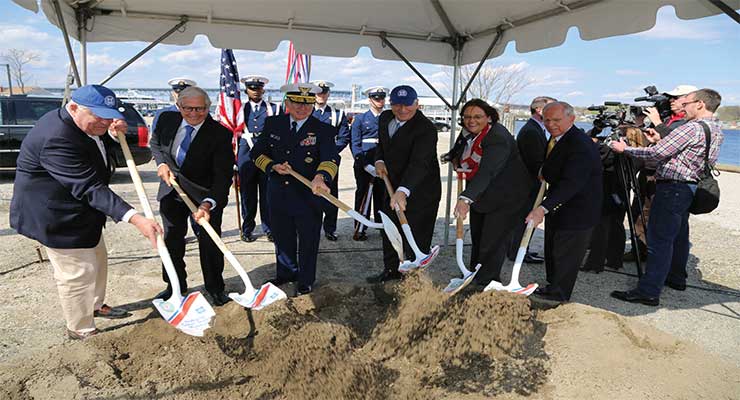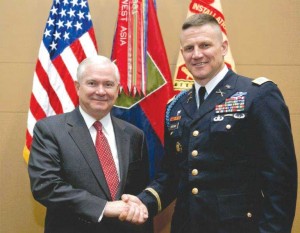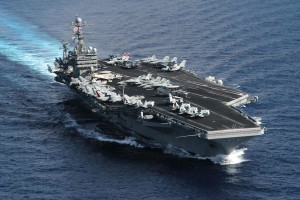
CG347: May 2, 2014: History in the Making
National Coast Guard Museum Association board members join Adm. Robert J. Papp, Coast Guard Commandant (center) in letting the ceremonial dirt fly. (l-r) John S. Johnson, Treasurer; James J. Coleman, Jr., Chairman; Richard J. Grahn, Esq., Secretary; Hon. Catherine W. Cook and RADM John N. Faigle, USCG (Ret.) CG51: (l-r) Seamen Mockler, Linton, King and Yeacer of the United States Ceremonial Honor Guard stand ready to post the colors. CG90: Coast Guard Commandant Adm. Robert J. Papp Jr. and James J. Coleman, Chairman of the National Coast Guard Museum Association, salute the colors.
Coast Guard Museum Groundbreaking
By Jon Persson
On May 2nd, Admiral Robert Papp formally accepted the transfer of the property deed from the City of New London to the United States Coast Guard where the National Coast Guard Museum will soon be built.
The pomp of these ceremonies is underscored by the towering presence of the Coast Guard barque Eagle, and CG36500, the lifeboat that rescued 32 crew members from the sinking tanker Pendleton during a fierce storm in February, 1952.
The first of the two ceremonies, held on the afternoon of May 2nd, officially transfers ownership of the waterfront property bordered by Union Station and the Cross Sound Ferry complex. New London Mayor Daryl Justin Finizio gives a brief legal tutorial on the procedure for such transfer: after being sworn in, he signs the document on behalf of the entire city of New London. Admiral Papp then signs on behalf of the United States government. Mayor Finizio has asked that Mayors Henchey and Galbreath of Norwich and Groton witness the signing, in recognition of the two neighboring cities which share New London’s harbor.
Mayor Finizio and Admiral Papp are joined by Governor Dannel Malloy, Senators Chris Murphy and Richard Blumenthal, and Representative Joe Courtney. Senator Chris Murphy notes that “efforts that are most worth it are always difficult,” adding that the Revenue Cutter Service, which later became the Coast Guard, was America’s “only naval force for the first ten years” of the nation. Governor Dannel Malloy offers that the history and presence of the Coast Guard has made it apparent that the “Coast Guard Museum needs to be in New London.”
Senator Richard Blumenthal promises to continue the difficult quest for funding, which has been bolstered by Governor Malloy’s pledge of $20 million dollars from the State. Representative Joe Courtney is quick to remember the work of Senators Joe Lieberman and Chris Dodd, and of his own predecessor Representative Rob Simmons, in establishing the legislative framework for the Coast Guard Museum to be specifically located in New London.
Finally, Jimmy Coleman, Chairman of the National Coast Guard Museum Association, is introduced with the most poignant announcement of the day, that of a personal pledge of $150,000 to the museum project. With now-familiar modesty he offers praise for the work and exploits of others engaged in the task to memorialize the contributions of the men and women United States Coast Guard.
The ceremonies close with a symbolic breaking of ground by the official party, Senators and Mayors wielding shovels embossed with the emblem of the Coast Guard. Funds still need to be raised and appropriated, contracts awarded, logistics worked out all before this museum can become a reality. Celebrity figures, John Amos and Arnold Palmer amongst them, have already joined the effort. The process has begun.

